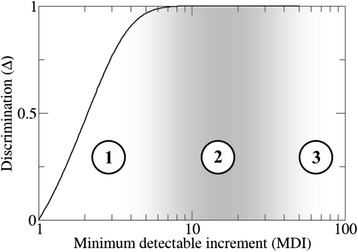Figure 4.

Discrimination ability ∆ as a function of the minimum detectable increment MDI (eqn. 3 ). The ability of the IS to detect tumors depends on the region where it works. In region 1, the IS responds to small changes in effective abundances with low discrimination, which implies a higher risk of autoimmunity. In region 2 (shaded area), the IS responds to moderate variations in self-Ags with high discrimination making it optimal to detect tumors correctly. In region 3, large increases in effective abundances are required to make self-Ag detectable. Actually, the IS of vertebrates seems to be working in this third region. Notice that the border between regions 2 and 3 is somehow arbitrary, since a better characterization of fluctuations in Ag effective abundances would be required in order to decide what a “large” change is (see Discussion).
